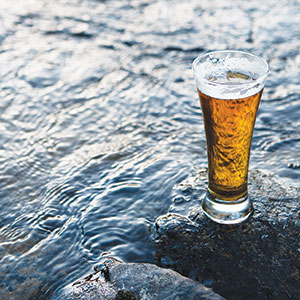

Some of this country’s cheapest and least flavorful domestic beers make a lot of noise about water. There’s the iconic, grizzled drawl of actor Sam Elliott pronouncing that for Coors Brewing Company, “it’s rocky mountain water or nothing.” Hamm’s tells its drinkers that it is “born in the land of sky blue waters.” Olympia keeps things even simpler: “It’s the water” is their slogan.
Turns out it’s more than just marketing-speak.
“It’s one of the most underrated components of beer,” says Elliot Hoffman, assistant brewer at Camino Brewing. “Historically, it’s actually been one of the most defining factors for styles.”
Pilsners, which originated in the Czech Republic in the mid-1800s, were at first brewed with what we’d call “soft” water, low in free ions such as calcium and magnesium. This relatively soft water was instrumental in creating the signature flavor profile of a classic pilsner.
But that doesn’t mean ion-free water is ideal for all styles of beer. “The higher sulfate count you have in your water, the better the water will isomerize alpha acids, or create bitterness,” Hoffman explains, pointing to the English town of Burton-on-Trent, which is known among British IPA lovers for making some of the best bitter brew in the country. “They were making hoppy beers because they liked the way they tasted, but also because they were able to get flavors no one else could produce because their water was so high in sulfates.”
As for the water in Silicon Valley… well, Hoffman says, it leaves something to be desired from a brewing standpoint.
“Santa Clara County is absolutely notorious for having awful water for brewing beer,” he says. It’s a problem anyone without a water softener built into their home can understand. Brewing equipment is just as prone to calcification as the faucet or showerhead. But there’s more to it than that. The water is also rather alkaline, which negatively impacts yeast.
“The majority of successful brewers in the South Bay and Santa Clara County end up having to use reverse osmosis water filtration,” also known as a water softener, he explains.
In fact, the technology is also essential to maintaining the long-term health of espresso machines and in producing craft cocktails, as tainted ice can interfere with the delicate flavor balance mixologists seek to create.
Reverse osmosis filtration works by capturing the free calcium and magnesium ions floating in a given water supply. In fact, the highest-quality reverse osmosis systems should be able to bring any water to a near neutral pH of 7. Camino’s filter tends to spit out water that scores about 6.5 on the Carlsberg Laboratory-developed scale and manages to eliminate almost all of the calcium.
“Our city water, in terms of calcium hardness, can be upwards of 160 parts per million,” he says. “The reverse osmosis water is, like, five.”
However, as Hoffman noted in pointing out Burton-on-Trent’s famed IPAs, an entirely neutral water source isn’t always what he and his team are looking for. And so they blend their almost pure water with city water and other “brewing salts”essentially isolated minerals and other componentsto produce a water profile that is most conducive for the type of beer they are creating.
When brewing IPAs, they will add sulfates to aid in hop extraction. But with their pilsners, they add very little city water to the mix, as they are attempting to replicate the ultra-soft Czech water that first gave birth to the pils.
While water softening systems are nothing new, their importance in the modern craft beer movement cannot be overstated. Without the ability to strip water of its naturally occurring ions and then strategically add select elements back, no brewer anywhere would be able to produce the range of beers that modern beer makers can.
Without this filtration technology, which first came into mainstream use in the 1970s, “brewing in San Jose would be near impossible, unless you just made porters or stouts,” Hoffman says, noting that before reverse osmosis, brewers had to rely on the unique profile of the water in their municipal systems. Today, breweries all over Silicon Valleyand all over the worldare producing beers that are dark and malty, light and crisp, cloudy and hoppy.
We’ll drink to that.



